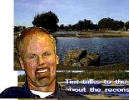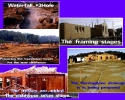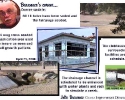Category: History
Tim Heck Interview During Construction Phase (1999)
An interview with Tim Heck, Golf Services Manager in charge of the San Mateo golf course reconstruction project.
Julio Brassesco, Course Improvement Director and Jack Zanette of the San Mateo Golf Club interviewed Tim Heck November 23, 1999.
 Julio: It seems like yesterday that you and your crew started the project: the trucks bringing in the fill, the heavy equipment moving the yards of dirt, the ground testing for surface water, etc.. During this period I'm sure you had concerns on the how-to's, getting to that next step and that gray area "the unknowns." What was it like and what were the priorities?
Julio: It seems like yesterday that you and your crew started the project: the trucks bringing in the fill, the heavy equipment moving the yards of dirt, the ground testing for surface water, etc.. During this period I'm sure you had concerns on the how-to's, getting to that next step and that gray area "the unknowns." What was it like and what were the priorities?
Tim: At the time we had two priorities. One was preparing the clubhouse site for the wick drains and stock piling the site with dirt to get the soil consolidated. This procedure required constant monitoring and the time frame to start clubhouse construction had to wait until the compaction was complete. The other priority was engineering and installing the underground drainage system.
The system is now in and we welcomed the recent rain. It gave us an opportunity to check the system and the grading that has been done to look for low spots where water could collect. The new drainage worked like a champion, it handled the runoff as planned. When we started this project the number one priority was the course drainage system, it had to drain well… or you'd be talking to me from a different golf course. The system works and is operating properly. We are confident the new course will allow play throughout the year.
Julio: The project was estimated at $10 million dollars to complete. Are you holding to the budget?
Tim: Yes we are and as a matter of fact we have a little surplus and if we can hold to the underrun we may look at sod versus seeding for the greens. Within the next several weeks we will evaluate our position regarding costs and growth patterns. If the budget continues to underrun, we may elect to sod the greens.
Julio: What impresses me is the engineering that had to be accomplished to install the drainage and flood control systems. What kind of study and implementation plans did you engage in this part of the project?
Tim: This is why we're spending $10 million dollars. If we were building a course on a hillside or terrain that had natural runoff, project costs would not be anywhere near this figure. The complexities of trying to drain a flat parcel of ground that is 105 acres, that is lower than sea level and is subjected to the bay tides requires a lot of study and calculations. The other goal was to engineer a system without the need for multi pump stations scattered over the course that would disrupt the look of the course and also require constant maintenance and repair. With this goal in mind, the architect designed a single lift station to handle the drainage and pump runoff into the canal. This accomplishment makes it all work with the topography of the land and without any gimmicky stuff on the golf course. Now the course will have free flowing uninterrupted aesthetically and pleasing views of the fairways and greens.
Julio: Explain to us the materials used to make up the composition of the ponds and lakes?
Tim: After deciding the exact locations, the shape and the size, the designated areas were dug out. They were then lined with a 30 mil. thick pvc liner that covered the basin . The liners of plastic were glued together and laid down as one solid sheet. Next hydrostatic valves were installed on the bottom of the bed. The valves penetrate the liner so if ground water gets underneath the covering it will release the water through these valves to prevent the liner floating up into the lake. Also it will make it easier to empty the lakes if emergency repair or maintenance is required. Around the rim of each pond and lake about 6 feet down the slope, gunite was applied about 4 to 6 inches thick. This was done as a protection to prevent the liner from being damaged by exposure to ultraviolet rays. The gunite was applied six feet down, deep enough to defuse the ultraviolet rays removing any chance of deteriorating the liner. We also imported rocks and stained the concrete to give the illusion of a natural setting
Julio: The pond with the water fall and the two lakes that are located next to the freeway, I assume was done for appearance sake because of its exposure to the public. Were there other reasons for this location?
Tim: Yes we wanted to make this area especially attractive because it is the first view you have as you approach the course. However, the two large lakes will serve as our main water source for irrigation. In the past, we drew water from the pond that was located between the 16th and 18th holes. The problem with that location forced us to pump the water from our wells all the way across the course. As I mentioned earlier, we overcame this problem, by placing the main pump station next to the wells. By locating everything in this area, we were able to remove the old pump station that resided off the the 1st tee. The new pump station is off the course and out of sight in the maintenance area. The two new lakes hold about eight times more water than the old reservoir, which will reduce the drop in the lake water levels during irrigation. The new wells we drilled will produce 900 gallons a minute . Just about three times more than the old one. This is a much more efficient system and will reduce the amount of time it takes to irrigate the course.
Julio: The clubhouse is framed and the parking areas are just about complete. What are the next stages surrounding the construction and completion date?
Tim: The first thing we wanted to complete was getting the slab down. Once that was completed, we could then work through inclement weather. Unless we have heavy rainfall, the construction will not be hindered. The framing and sheathing are almost complete and will start shortly putting up the roof trusses. The critical operation for opening the course will be the completion of the clubhouse. This requires tight scheduling of the sub contractors and my experience tells me it will be ongoing up through the opening day. It may be 30 minutes before we open our doors that we will still be shining fixtures and vacuuming the carpets.
Julio: There is talk that the seeding of the fairways and greens was to start in November. What are the time frames involved?
Tim: Scheduling this event will be an intricate timing process. Once the fairway is prepared for seed, we cannot permit any kind of traffic to pass over the area. This means before we can seed a fairway and green, we have to make sure that all the irrigation systems are in place and properly working, e.g., the heads are on, flushed and operable, etc. Next is to do the final shaping of the fairway and give it one last pass. At this point it is ready for fertilizer and seed. But before we can complete these tasks of prep and seeding, the gravel and sand for the bunkers and greens must all be in place, and the cart paths completed. All 18 holes will follow the same procedure. Without careful planning, truck traffic could damage cart paths and the newly sculpted fairways. Timing strategies for each phase have been carefully planned out. It is a very intricate scheduling process and will require close supervision and monitoring. Also as a preventative step, we will bring in sod to surround the cut greens and bunkers to prevent water entering and causing mud runoff during heavy rains.
Jack: Where is the sand and gravel coming from?
Tim: The sand is coming from Redwood City and the gravel is being brought in from Pleasanton. To give a little more background on the construction of a green, a green is excavated to a depth of 16 inches. The outline of the excavation is the exact shape of the finished green and the bottom of the excavation is shaped to mirror the contours of the finished green. A herringbone style drainage system is then installed with a perforated drainage pipe to collect the water. Four inches of gravel is then laid over the system and 12 inches of sand is put over the top to make the green ready for the seed or sod.
Julio: The rumor is that the project is falling behind schedule. Will the course be ready on time?
Tim: Yes, I feel confident the course will open as scheduled. The unknown is how fast the grass will grow. Typically, areas on the course take different growing periods. The fair ways are more flexible and we can do things to help the growing process. The greens are more delicate and require more care. They are cut shorter and have a tight root system. Generally, the greens require six months growth to handle the foot traffic of golf play. All of the growth patterns are dependent on the weather and the ground temperature. Sod does give us a head start and cuts the time period by a couple of months. The down side is sod costs about $100,000 more. To get back to your original question, we will do whatever it takes to open on time.
Julio: What kind of grass are you using for the greens?
Tim: It is going to be bent grass and we are leaning toward a variety called Dominant Plus. It is a blend of three types of bent grass. One of the types does better in warm weather while another does better in cool weather. The third type crosses both types. The benefit in having a three-way blend is which ever type does best in our particular climate will become the dominant grass.
Julio: The San Mateo Golf Club is quite anxious to get back to its course. We feel like orphan kids without a home. What can we do to assist you and your staff?
Tim: We are anxious to have the men's club back and will be getting together with everybody after the first of the year. I look forward to your suggestions and ideas on the kind of events to celebrate the opening. Every day that I go out I see the shape it is taking and I am very pleased. I see a beautiful golf course coming our way. While I was standing on the new 16th tee looking down what used to be the 18th fairway, I remembered how it used to look, the old pump station, the old shed that housed the electric panel covered by a crappy plastic roof, the prison yard cage that encircled the first tee, and the ugly chain link fence. Now with that gone, you see beautiful rolling mounds, huge trees, and a full view of Coyote Point.
Jack: Tim give us a little background on your work experience. I know our members would be interested.
Tim: My background is in construction. I have been in the building business for 25 years. I started as an apprentice carpenter out of high school and worked myself through college. I went through the management ranks in all of the administrative parts of the building industry. About ten years ago, I went to work for a developer in the Petaluma area who was just finished the Adobe Creek golf course. I was hired as a construction manager and built the club house and the infrastructure around the course. On that same project, I then built 300 houses that surrounded the course. During this period, the sales prices of the homes were tied to the success of the course. As a result, I became so involved with the project that I was hired to manage the golf course. I found during that period of time I liked the golf course business more than the construction business. When the opportunity came to take over this project in San Mateo it was a dream come true for me. I am very fortunate that I was selected for this position and for me it is a once in a career opportunity. I guess the most exciting part for me was the designing, the reshaping, and the implementation of the plans that once were sketches on a drawing board.
Jack: What's next for Tim?
Tim: The next step that I am looking forward to is the running of the golf course. We have a great opportunity now because the closure of the course gives us time to evaluate and implement new procedures. It is quite difficult to make changes to a golf course while it is still in operation. There is that ongoing resistance by the golfers who play on it and the people who run it that makes changes almost impossible. During the next few months we will be looking at policies for making reservations, tournament events, and the overall managing of the pro shop and restaurant facilities. Also we are going to look at marshaling guidelines and procedures so that we can make the game enjoyable for our players and keeping a round of golf within the 4 to 4 1/2 hour time frame.
Jack: We feel the same enthusiasm as you do Tim and we are also using this down time as an opportunity to re-evaluate our club's charter and reposition our thinking in the areas of tournament sign ups, handicap systems, membership recruiting and the clubs community involvement. Tim, on behalf of the San Mateo Golf Club, Julio and I thank you for your time. I know that your input from this interview will enlighten our members and answer many of the questions surrounding the reconstruction of the San Mateo Golf Course.
San Mateo Golf Club Establishes Internet Presence (1999)
66 year-old golf club moves into Cyberspace…
June 9, 1999 — The 66 year old San Mateo Men’s Golf Club has announced that they have secured the internet domain, http://smgc.net and intend to have a permanent web presence.
Ironically, along with this announcement, the men’s golf club is without a home course, as the City of San Mateo is undertaking a major, $10 million renovation, which has the course closed until June of 2000.
“The San Mateo Men’s Golf Club (SMGC) is alive and well and continuing to attract new members throughout the closed period”, says SMGC President Bill Stevens. The anticipation of the new, greatly refined golf course, along with a state-of-the-art Pro Shop and restaurant facilities, continues to drive membership.”
“Now that we have a presence on the web”, adds Stevens, “new members can join the club on a 24 x 7 basis, (24 hours, 7 day-a week) directly from their home PC.” “The possibilities for our new web site are endless. Eventually, our new web site will offer the membership the opportunity to sign up and pay for tournaments, from the comfort of their own home, via their PC.”
Tournament Chairman Scott Smith continues to wrestle with the tournament schedule during this difficult communications period, while the course is closed and face-to-face communication are interrupted. “No longer can the tournament schedules or tournament changes be posted in a location at the club, where people congregate”, says Smith. “Even though our schedule is mailed out to all members, the tournament posting and change process gets no immediate view by the membership. Our new web site should take care of that during the closure period and into the millennium.”
Club Secretary Dave D’Arche, has been preparing to design and launch the club’s new web site for a month or so. D’Arche, a 20 year veteran in the PC services industry, has helped to move the SMGC to computerize their entire back-office operations, which included a greatly-enhanced membership renewal system, a new Microsoft Access membership database and other systems. “One of our near-term goals, is to offer web-based tournament signup along with a web-based, credit card payment system. Of equal importance, we are prioritizing the web-based credit-card system to be up and running and thoroughly tested, so that we can utilize it for the upcoming membership dues renewal process this fall,” says D’Arche.
San Mateo Golf Course Grand Opening (1933)
The following article appeared in issues of the 1933 San Mateo Times:
In 1933, the opening day began promptly at 2 pm. with two dedication matches. A gallery of more than 600 people followed the first match as Miss Marion Hollins, former U.S. Women champion, paired with Adrian Wilson, Pasatiempo pro started against Clara Calendar, a 13-year-old Belle Monti women champion, and Harold Sampson, Burlingame Country Club professional.
Immediately following the first group were Mayor Aylett R. Cotton and San Mateo Councilman Justin Fitzgerald in a foursome with Mayor C.A. Buck and Burlingame Councilman Ernest Richard.
Earlier that day, eminent figures in Northern California golfdom and civic officials of San Mateo gathered at the Benjamin Franklin hotel at noon for luncheon and formal dedication ceremonies. Amid congratulations and glowing praise, the city of San Mateo dedicated its new $45,000 eighteen-hole municipal golf course.
The Mayor gave members of the advisory committee unstinted praise in their combined efforts to bring about the successful conclusion to the project.
Jim Hackney, the small Scot from Carnoustie, spent the day at his professional’s shop, meeting and welcoming the throng of golfers. His assistant professional, Bert Dwyer, was busy supplying balls, tees and golf knick-knacks.
It was a day of rushing business for Jim Inglis who had the concession for lunch roe and fountain at the clubhouse. Scores of golfers crowded his room for “nineteenth hole” beer.
The City Manager and other city officials spent most of the day at the clubhouse receiving congratulations.



